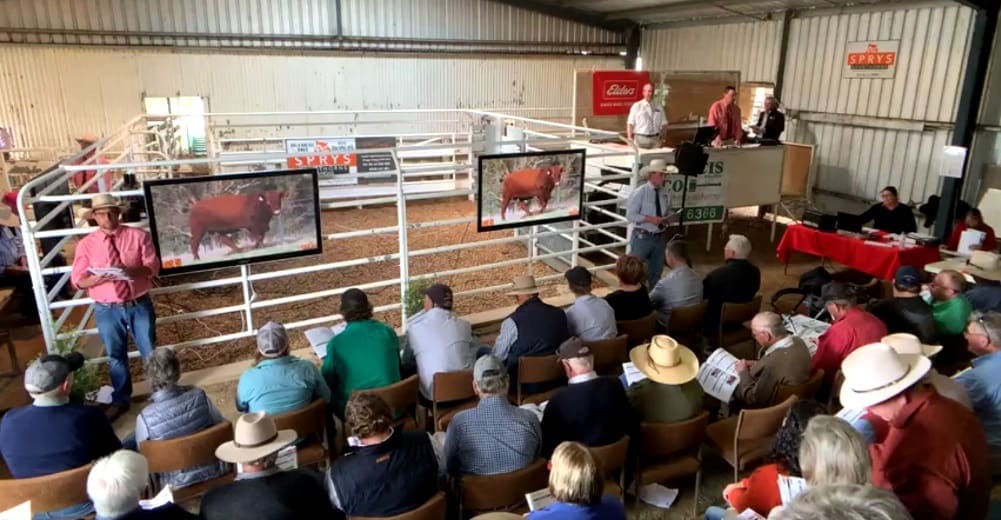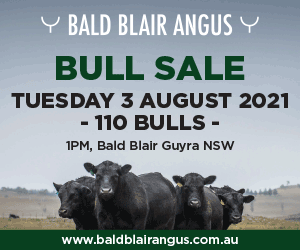
Spry’s Shorthorn and Angus sale featured video footage of each bull displayed on a series of large video screens in front of the bidding audience, instead of running each bull through the ring. Bulls were still available for physical pre-sale inspection out the back.
BULL sales tend to follow a fairly similar format across the country. Sales are characterised by distinct segments, including time for pre-sale inspections ahead of the auction of the bulls advertised.
The format provides producers with opportunities to inspect animals in their own time, while getting a second viewing as the auction commences.
However, the process, particularly for bulls passing through a sale ring, is not always a smooth or stress-free occasion. Most sales see the occasional animal that reacts to the sudden exposure to noise, people, and small spaces in a less than desirable way.
 It is hard to know how great the impact of this behaviour may be on the purchase price of the animal. In the case of animals reacting very badly, some bulls have been passed in, or overlooked as a result.
It is hard to know how great the impact of this behaviour may be on the purchase price of the animal. In the case of animals reacting very badly, some bulls have been passed in, or overlooked as a result.
While temperament is an essential trait to assess, the sale ring may not always be the most appropriate place to make that selection. The level of stress in the sale process is probably the most novel event a bull can face, and it’s unlikely to be replicated in the animal’s lifetime.
Reducing stress at sale time is increasingly becoming a focus for seedstock producers.
While not wanting to move away from on-farm sales where bull buyers attend in person, there are a number of seedstock producers across breeds moving to a video auction of the bulls, rather than move them through the sale ring in front of bidders. The format of these sale days remains identical to the traditional ‘physical’ sale, with bulls yarded for pre-sale inspections by buyers, and the auction proceeding in catalogue order.
Removing stress, improving safety and efficiency
Well-known Shorthorn breeder Gerald Spry, from Wagga Wagga in NSW has used video of bulls offered in his on-farm sales for several years. He describes the move to video selling as a “game changer.”
We wouldn’t go back to using a ring to sell,” he said.
Asked to explain the advantages, Mr Spry highlighted the point that the move to video selling removed a huge degree of stress across the sale process.
“Firstly, it’s better for the cattle, they don’t get the stress or the upset that drafting and moving and going through a ring, in front of blaring load speakers. It’s a better way. But for us, drafting out the back, pushing into a ring, it all adds pressure and stress on the team, on the auctioneer and on us. Not having it is so much smoother,” Mr Spry said.
He also highlights the time saved under this selling process.
“We don’t have the hold-up on cattle coming into the ring, or moving animals around. Keeping the momentum going is important for a good sale.”
With many sales already incorporating a video component through simultaneous online bidding, the move to video-based physical sales is seen by some as the next phase for sales.
A seedstock breeder who asked not to be identified described the transition as the logical move in order to “reduce the WHS risk at sales, and to build the online opportunities for clients living interstate.”
“With Covid, people are not travelling so much, and since last year they are more open to buying online, using video. So, if we have to film the bulls to make that happen, we may as well use it as the principal method of sale, for those attending in person.”
The advice for breeders thinking of the move to video-based physical sales is to ensure that the videos are professionally produced, and the presentation is visible when projected in front of the buyers. Several high-profile sales this year used large high-quality television screens to offer clients every opportunity to see and consider each lot offered on-screen – having inspected them ‘in the flesh’ in the adjacent pens earlier.
As breeders continue to explore the opportunities that technology offers, along with finding greater efficiencies in their selling process, its more than likely that more bull sales will move away from the ring, and onto the screen.
 Alastair Rayner is the Principal of RaynerAg, an agricultural advisory service based in NSW. RaynerAg is affiliated with BJA Stock & Station Agents. He regularly lists and sell cattle for clients as well attending bull sales to support client purchases. Alastair provides pre-sale selections and classifications for seedstock producers in NSW, Qld, and Victoria. He can be contacted here or through his website www.raynerag.com.au
Alastair Rayner is the Principal of RaynerAg, an agricultural advisory service based in NSW. RaynerAg is affiliated with BJA Stock & Station Agents. He regularly lists and sell cattle for clients as well attending bull sales to support client purchases. Alastair provides pre-sale selections and classifications for seedstock producers in NSW, Qld, and Victoria. He can be contacted here or through his website www.raynerag.com.au



We started bull sales by video auction in the early 2000s and have now held more than 30 video sales. We were the first herd to do so and did this to make our sales available to far flung clients who wanted to see the bulls but couldn’t always get to the sale. The benefits to the animals and people on sale day became apparent pretty quickly, the bulls sit quietly outside and people can move in and out of the pens as they inspect later lots. Like a lot of innovations there were detractors at the beginning. For the first 8 years we sent out CDs with our catalogue and it was a relief when we no longer had to do that and could host them on the web.
It has also meant that our shed infrastructure can be used for other purposes during the year. In those 30 + sales we have sold more than $25m of bulls through the video auctions, one of our auctioneers has sold at every sale.